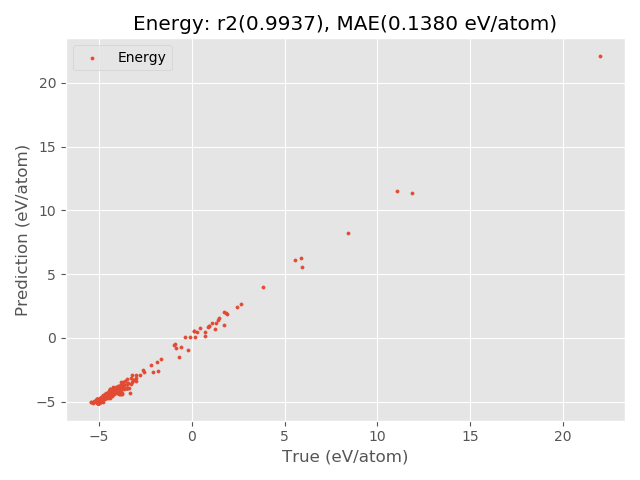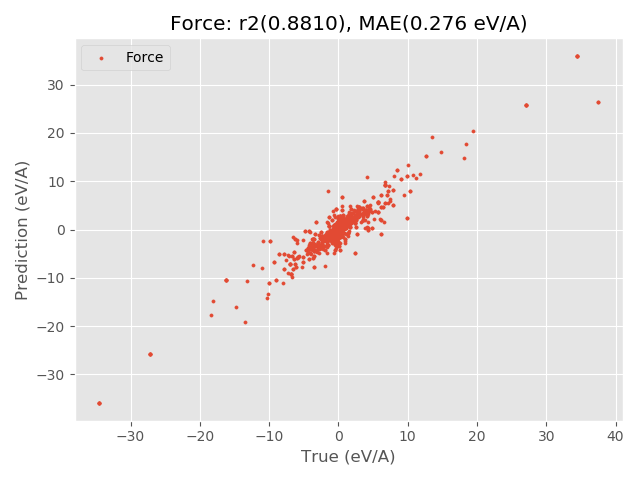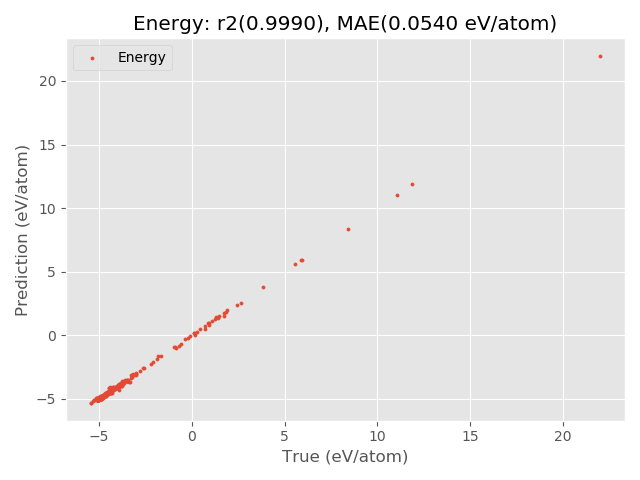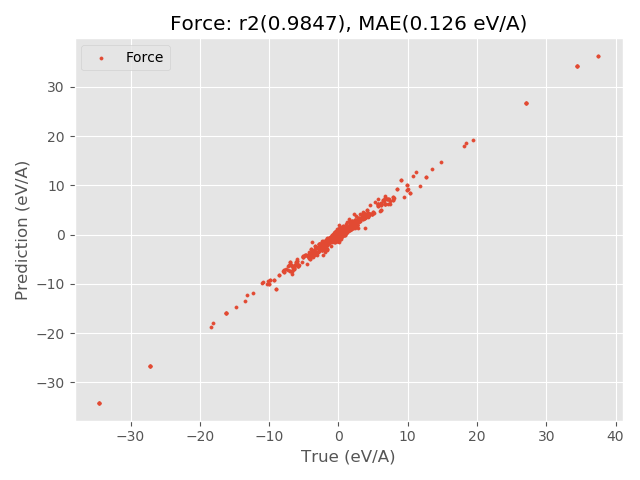Quick Start¶
Below is a quick example to quickly make a force field for silicon.
from pyxtal_ff import PyXtal_FF
train_data = "pyxtal_ff/datasets/Si/PyXtal/Si8.json"
descriptors = {'type': 'SOAP',
'Rc': 5.0,
'parameters': {'lmax': 4, 'nmax': 3},
'N_train': 400,
}
model = {'system': ['Si'],
'hiddenlayers': [16, 16],
}
ff = PyXtal_FF(descriptors=descriptors, model=model)
ff.run(mode='train', TrainData=train_data)
The script will first compute the SOAP descriptor .
As long as the descritors are obtained, they will be fed to the neural network trainining.
Below is an example output from this quick script.
______ _ _ _ _______ _______
(_____ \ \ \ / / | | (_______|_______)
_____) ) _ \ \/ / |_ ____| | _____ _____
| ____/ | | | ) (| _)/ _ | | | ___) | ___)
| | | |_| |/ /\ \ |_( ( | | |_______| | | |
|_| \__ /_/ \_\___)_||_|_(_______)_| |_|
(____/
================================= version 0.0.9 =================================
Descriptor parameters:
type : SOAP
Rc : 5.0
nmax : 3
lmax : 4
2012 structures have been loaded.
Computing the descriptors...
400 out of 400
Saving descriptor-feature data to Si-SOAP/Train_db.dat
==================================== Training ====================================
No of structures : 400
No of descriptors : 30
No of parameters : 785
No of epochs : 1
Optimizer : lbfgs
Force_coefficient : 0.03
Stress_coefficient : None
Batch_size : None
Iteration 99:
eng_loss: 0.020505 force_loss: 0.022794 stress_loss: 0.000000 regularization: 0.000000
Loss: 0.043299 Energy MAE: 0.1383 Force MAE: 0.2759 Stress MAE: 0.0000
Iteration 100:
eng_loss: 0.020105 force_loss: 0.022543 stress_loss: 0.000000 regularization: 0.000000
Loss: 0.042649 Energy MAE: 0.1380 Force MAE: 0.2756 Stress MAE: 0.0000
The training time: 116.85 s
The Neural Network Potential is exported to Si-SOAP/16-16-checkpoint.pth
============================= Evaluating Training Set ============================
The results for energy:
Energy R2 0.993670
Energy MAE 0.138006
Energy RMSE 0.200526
The energy figure is exported to: Si-SOAP/Energy_Train.png
The results for force:
Force R2 0.880971
Force MAE 0.275650
Force RMSE 0.707787
The force figure is exported to: Si-SOAP/Force_Train.png
After the training is complete, the optimized weight information will be stored as Si-SOAP/16-16-checkpoint.pth, where 16-16 describes the neuron information.
In the meantime, the code also provide graphicial output to facilitate the analysis.


If you feel that the quality of results are not satisfactory, you can contine the training from the previous run file (Si-SOAP/16-16-checkpoint.pth) with the restart option.
from pyxtal_ff import PyXtal_FF
train_data = "pyxtal_ff/datasets/Si/PyXtal/Si8.json"
descriptors = {'type': 'SOAP',
'Rc': 5.0,
'parameters': {'lmax': 4, 'nmax': 3},
'N_train': 400,
}
model = {'system': ['Si'],
'hiddenlayers': [16, 16],
'restart': 'Si-SOAP/16-16-checkpoint.pth',
}
ff = PyXtal_FF(descriptors=descriptors, model=model)
ff.run(mode='train', TrainData=train_data)
The results for energy:
Energy R2 0.997013
Energy MAE 0.093162
Energy RMSE 0.137752
The energy figure is exported to: Si-SOAP/Energy_Train.png
The results for force:
Force R2 0.951379
Force MAE 0.200881
Force RMSE 0.452365
The force figure is exported to: Si-SOAP/Force_Train.png
Clearly, running another 100 training steps notably reduces the MAE values.
Thereforce, we can continue to train it by specifying the epoch option.
from pyxtal_ff import PyXtal_FF
train_data = "pyxtal_ff/datasets/Si/PyXtal/Si8.json"
descriptors = {'type': 'SOAP',
'Rc': 5.0,
'parameters': {'lmax': 4, 'nmax': 3},
'N_train': 400,
}
model = {'system': ['Si'],
'hiddenlayers': [16, 16],
'restart': 'Si-SOAP/16-16-checkpoint.pth',
'epoch': 600,
}
ff = PyXtal_FF(descriptors=descriptors, model=model)
ff.run(mode='train', TrainData=train_data)
Below are the results after 1000 steps of training.

